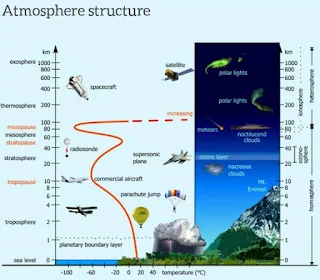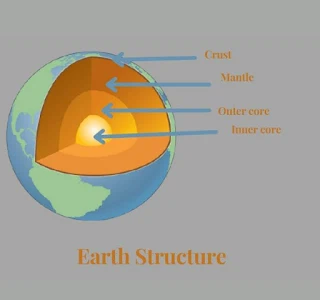Structure of the Layers of the Athmosphere
The atmosphere is a layer of air that surrounds the earth. Its thickness reaches 650 kilometers. The air in the atmosphere can move due to the influence of the heating of the sun and the rotation of the earth. The difference in air pressure that occurs in the earth's atmosphere is caused by the influence of the rotation of the earth which will then cause wind currents.
The structure of the layers of the atmosphere has different temperatures and altitudes. There are various tools used to measure it. For example, for a layer as high as 30 km, it is measured using a radiosonde. For an altitude of 90 km, measured using a rocket. Satellites are also used to measure atmospheric layers above an altitude of 90 km.
Structure of the Layers of Earth's Atmosphere, are:
1. Troposphere
This layer is located at the very bottom. The mixture of gases is best for sustaining life on earth. This layer protects the earth from the sting of radiation emitted by celestial bodies, such as the sun.
This layer is only 15 kilometers thick from the ground surface and is the thinnest of the other layers of the atmosphere. Sudden changes in weather and temperature, air pressure, wind, and humidity, occur in this layer. The tropopause separates the troposphere and stratosphere.
2. Stratosphere
The difference between the thickness of the troposphere to the stratosphere is 11 kilometers. The temperature at the lowest level is very cold, which is around -700F or around -570C. The concentration of ozone is increasing as you go up.
This causes the middle part of the stratosphere to rise above the temperature. The temperature in this layer reaches 180 C at an altitude of about 40 kilometers. The stratosphere and subsequent layers are separated by the stratopouse.
3. Mesosphere
This layer is 50-70 kilometers above the surface of the stratosphere. The temperature decreases with increasing altitude. At an altitude of 75 kilometers, the temperature is around – 720C. The lowest temperature is at an altitude of 80-100 kilometers. The mesopause separates the mesosphere and thermosphere. The Mesopause has the lowest temperature – 1100C.
4. Thermosphere
This layer is 75 kilometers above the mesopause to an altitude of 650 kilometers. In this layer, the gases are ionized. Therefore, this layer is called the ionosphere layer. Oxygen molecules will split into atoms in the thermosphere layer. Solving it will produce heat so that the temperature increases. Altitude also affects the increasing temperature of this layer. The ionosphere is divided into 3 parts.
Air layer E. Located between 80–150 kilometers from sea level. Here, the highest ionization process occurs. Radio waves can be reflected in this layer. The temperature in this layer ranges from -700C–500C.
Air layer F. Located between 150–400 kilometers from sea level.
Atomic air layer. All objects in this layer are atoms. Located between 400–800 kilometers from sea level. The direct heat of the sun it receives reaches 12000C.
5. Exosphere
The outermost layer of the atmosphere contains very low atmospheric gases. The boundary between the atmosphere and outer space is not clear. There is an imaginary line that separates the mesosphere from outer space called the magnetopause.
Structure of the Earth's Layers The Earth
The Earth's Layer Structure - Understanding the Lithosphere as the Earth's
Layer The earth's layer in scientific language is also known as the lithosphere. Lithosphere has a word meaning derived from lithos which means stone, and also sphaira which means sphere. The lithosphere in the language of geography is termed as a layer that surrounds the earth with a thickness of about 1250 km, following and adjusting the shape of the earth.
The thickness of the earth is actually not evenly distributed. In some parts, the earth will look flat, but in others it will look like chasms. Often the earth is seen and appears as oceans and seas.
The layers of the earth are composed of several layers which can be observed as follows:
1. Barisphere
Barisphere is the core layer that is in the center of the earth. This layer is composed of several solid layers consisting of layers known as nife. Nife is a combination of niccolum or nickel, and also ferrum = which is iron. Barisfer has a radius of about 3243 km in length, with a thickness of about 2,900 km.
2. Layer Intermediary
The intermediary layer is the layer at the top of the nife layer. This layer is slightly softer than the nife layer. The intermediate layer is also a layer that has a thickness of about 1750 km. It has a specific gravity which is said to have an average weight of 6 grams/cm.
Another name for the Intermediate layer is the asthenosphere or mantle. Called the mantle because this layer has a shape similar to the mantle. This layer is in the form of a liquid material, and glows.
3. Lithosphere
The lithosphere is located above the intermediate layer which has a thickness of up to 1230 km. Its specific gravity is 2.8 g/cm. The lithosphere is made up of two parts which are referred to as follows.
a. Sial Layer
This layer is a layer on the earth's crust which has an arrangement of several metals, namely silica and a metal in the form of aluminum. In this layer there are also several rocks such as sedimentary rocks, metamorphic rocks, and also other rocks.
These rocks are usually rocks found in various countries, as well as continents. The Damn layer, turns out to have another name as well, namely the crust layer. The nature of one of the structures of this layer of the earth is solid and also very rigid, and has a thickness of up to more than 36 km.
This crustal layer was also divided into several parts, namely as follows.
Continental crust, is a layer of solid soil and has an arrangement of granite at the top, while at the bottom it is decorated with rocks of granite and basalt. The name continental crust was taken because this crust actually filled the continents.
Oceanic crust, as the name given to it, oceanic crust is located at the bottom of the ocean, namely the upper part of the ocean floor. After that, the second part of this layer is filled with volcanic rocks and the lowest layer is composed of several rocks, namely gabbro igneous rocks and peridotite rocks. This entire oceanic crust covers the entire ocean floor on earth.
b. Sima layer
This layer is composed of several silicon metals and magnesium metals which are mixed well and neatly. In the top layer there are metals that have a density that is heavier than the layer after it. In this sima layer there is a layer of rock from basalt and also rock from iron. The thickness of this sima layer is about 66 km.
The rocks found in the earth's crust consist of several kinds, for example, rocks belonging to the type of igneous rock, sedimentary rock, and also metamorphic rock.
I. Igneous
Rocks This type of rock is called igneous rock. Because it is formed by the freezing process of incandescent magma which then cools and solidifies. Each type of igneous rock has a place to solidify, because it is then known several types of igneous rock.
Igneous Rocks (Igneous Rocks)
This rock is located in the earth, which is far from the earth's crust. This rock consists of a collection of crystals alone. Because the cooling is very long and slow, we form large crystals. An example of this igneous rock is granite.
Leleran Rocks (Outer)
Igneous RocksThese rocks also include igneous rocks but the freezing process is outside the earth. The cooling process is very fast compared to the edge rock, because the temperature of the magma melts is very fast and not slow.
Substances from this magma form crystals that are very fast and sharp. However, there are also some parts of this magma that cannot be crystallized. That's why this molten rock has a large crystal form, but there are also those that have a small crystal form, and also rocks composed of amorphous rock.
Korok Igneous Rock (Gang)
Korok Igneous Rockigneous rock undergoes a freezing process that is between the alleys in the earth. Therefore, the cooling process is very fast compared to the cooling process of deep rock. Igneous rock consists of various forms, some are small crystals, some are large crystals, but some are in the form of medium crystals. An example of this igneous rock is phosphire granite.
II. Sedimentary Rock (Sedimentary Rock)
Igneous rock that undergoes a weathering process, it will peel off here and there. Then the peeling of this loose rock will be carried away by wind, cold water, and also by ice. Furthermore, this chipped rock undergoes a deposition process in several places. So that the actual rock has initially softened, then solidified and hardened. This is the process of the occurrence of sedimentary rock in the structure of the earth's layers.
When examined from the medium that makes this igneous rock into sedimentary rock, there are several different intermediaries. Then these sedimentary rocks will be grouped into several parts.
Aeris Sedimentary Rocks
These rocks have wind as the intermediary medium. For example, loss soil, tuff soil, and sandy soil in the desert.
Glacial Sedimentary Rocks
Sedimentary rocks have ice as their carrier. An example is moraine.
Aquatic Sedimentary Rocks
As only the name given to them, these rocks are rocks with a water carrier. Consists of several rocks as follows.
Breccia, this sedimentary rock is a rock that is sharp and looks sharp. Between one another attached to one another.
Conglomerate, is a sedimentary rock that has a character consisting of rocks that are round in shape and can be glued together.
Sandstone
Such is the arrangement of the structure of the layers of the atmosphere and the layers of the earth. Hope it is useful!


